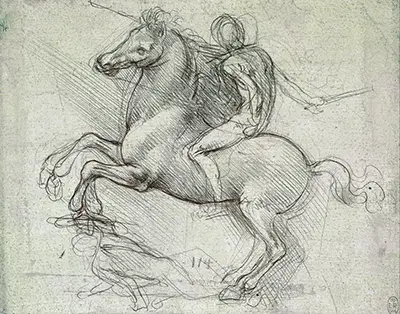In spite of the best endeavours of the Duke and the incredible craftsman, the Sforza horse monument would not move toward becoming a reality until the point when a resigned carrier pilot from Pennsylvania took it on as his very own central goal.
Not only did its sheer size make it a colossal test for da Vinci, however, but the artist was also creating The Last Supper and taking a shot at various ventures for his supporters at that time.
Ludovico 'Il Moro' Sforza was a far-fetched benefactor of expressions of the human experience. He was the fourth child of the soldier of fortune Francesco Sforza who had taken control of Milan in 1450 in the wake of starvation and mobs, and who was portrayed as a general renegade in Machiavelli's the Ruler.
After taking the honoured position in 1481 Ludovico and his great youthful spouse, Beatrice d'Este controlled at a time of abnormal imaginative and social development in Milan, against an approaching risk of ridiculous viciousness.
In 1482 Leonardo Da Vinci, by then as of now an expert specialist and artist, moved toward Ludovico looking for support. The Sforza family fortunes and at the expenses of the general population of Milan, went ahead to pay for a large number of Da Vinci's most celebrated works.
Appropriate from the earliest starting point, he started to chip away at the equestrian statue. In 1493 he introduced a 24 dirt model on the event of Ludovico's little girl's wedding, from which a bronze stallion could be made.
The dirt model remained set up until the point when the regional legislative issues turned grisly. Looking for a partner against Venice, Ludovico enabled French trespassers to pass however on their way down to Naples.
At the point when the French troops turned on him, he was compelled to utilize the 80 tons of bronze that had been put aside for the stallion to make weapons for the Clash of Fornovo, the first of many fights in the Italian Wars which encompassed Northern Italy.
At that point in 1499 attacking French bowmen utilized the large stallion for target work on, lessening the delicate model to remnants, and denoting the finish of the aesthetic blast times.
A 24-foot-tall earth model of the steed statue named Gran Cavallo, which had been disclosed in 1493. Over the past ten years, da Vinci had been occupied with gathering 58,000 pounds of tin and copper for the possible throwing of the figure, yet a French attack put him anticipates hold.
After the tin and copper were turned into guns and the eventual model destroyed in 1499 by French troops, Da Vinci fled Milan, purportedly with a broken heart at knowing his excellent steed could never be made.
In the disarray of those years, Da Vinci's moulds and draws of the first horse were lost, and the venture deserted. At that point, after five centuries Leonardo Da Vinci's lost notepads were found in the Biblioteca Nationale in Madrid in 1965, including his portrayals for the stallion.
In Allentown, Pennsylvania resigned pilot and gatherer or Renaissance artistry Charles Mark read about the scratch pad and the narrative of the never-assembled horse in National Geographic in 1977, and chose to finish the story.
His dream was to make the world's biggest bronze steed statue, which he named Il Cavallo, and offered it to the city of Milan. He looked for gifts and counsel from different researchers on whether the full-measure statue was achievable.
In 1982, he built up the not-for-profit Leonardo da Vinci's Stallion Inc. to guarantee the undertaking's consummation.
He expedited the stone carver Nina to understand the plan from Da Vinci's unique illustrations. It isn't precisely the same as Da Vinci's steed would have been. Nina Akamu told them that the figure which she made for the Leonardo da Vinci's Stallion Inc. pays reverence to the inventive virtuoso of Leonardo.
It isn't expected to be an entertainment of his model. Nonetheless, it has been altogether impacted by particular masterpieces and compositions from that period, and particularly Leonardo's scratchpad and going with illustrations with extraordinary accentuation on his inclusion with the Sforza landmark.
Charles Gouge passed on in 1994 preceding he could see his task finished. The last bronze stallion was introduced in Milan in 1999, 500 years after the first model was devastated. It stands 25 feet tall on an on a white Carrara marble platform and measures 15 tons.
The first 24-foot statue was uncovered in Milan, Italy, on September 10, 1999 — precisely 500 years after da Vinci's first dirt model was annihilated by attacking French troops.
The second steed was exhibited to people in general at Meijer Gardens on October 7, 1999. The primary distinction between the two figures is that the Italian adaptation remains on a marble base.
A moment throwing of the stallion is at the Frederik Meijer Greenery enclosures and Model Stop in Michigan, and two littler variants were introduced in Allentown, Pennsylvania to stamp Charles Mark's vision, and in the Piazza Della Libertà in Vinci, Italy where Leonardo was conceived.
